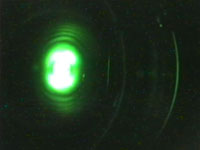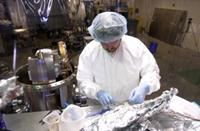Research Opportunities
In the structure and dynamics of materials, the JLab FEL User Facility offers research opportunities extending far outside the confined spectral regions available elsewhere, both in photon energy and electric field. Thus nonlinear as well as linear spectral response functions can be determined for materials in equilibrium and out of equilibrium.
Specifically, the FEL presents unprecedented opportunities for studies of material behavior, from protein folding and protein specific function (photosynthesis, metabolic pathways) to complex materials, non-Fermi metals, superconductors, and semiconductors. The source enables studies of chemical reaction dynamics and energy partition and flow. Although average powers are expected to be raised to tens of kilowatts, an external cavity will allow 100 pulses to be combined to increase the power per pulse at the expense of the repetition frequency. Peak electric fields are 1013 V/m at 1 μm wavelength. Terahertz light with fields of 107 V/m will be available from 0.1-5 THz, allowing—for the first time—nonlinear optical studies of critical materials in this regime.
In condensed-matter physics an understanding of correlated effects, described by various theoretical formalisms such as the Luttiger liquid formalism, can be obtained from frequency-dependent conductivity measurements for both ground and excited states. In principle, issues of key importance such as the behavior of complex materials can finally be fundamentally understood, for instance for materials exhibiting giant magneto-resistance and high-temperature superconductivity. Similarly enabled are experiments relevant for the revolution occurring in nanotechnology.
Biology profits from increasingly sophisticated measurements of protein and genomic form, but functional dynamics experiments require sophisticated tools that can tune to specific protein intramolecular vibrational modes since these likely determine folding and functional behavior. The FEL user facility will enable an understanding of energy transfer mechanisms in protein molecules.
In chemistry the FEL user facility will offer unprecedented opportunities for studies of Bose-Einstein condensates in a novel way in which the condensate is held by the pulsed high field but can be examined between pulses. With enhanced stacking schemes, the FEL will provide boosted single-pulse energies to a level suitable for gas-phase chemistry. At the forefront of theoretical and experimental inquiry in the gas phase are nonadiabatic dynamics and underlying factors controlling product branching, angular momentum, and energy disposal. The study of radical-molecule reaction dynamics in crossed beams, which has been beyond the capability of other probe techniques, promises detailed insight into these issues. Similar methods can be used to probe complex kinetics in multicomponent systems. The frontier of chemical kinetic investigations is the study of interacting systems of chemical reactions, whether in atmospheric, combustion, or industrial processing applications. Additionally the intramolecular excited-state energy pathways for both ground-state and excited-state Rydberg and even ionized atoms and molecules is central to our understanding of effects ranging from Earth-based chemistry to combustion dynamics to the evolution of the universe.



